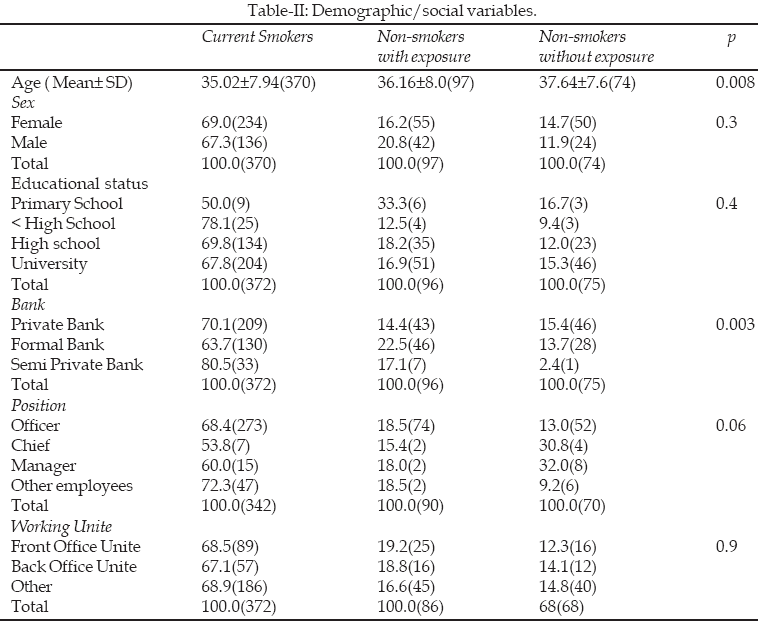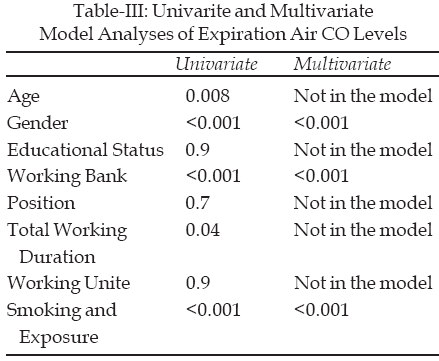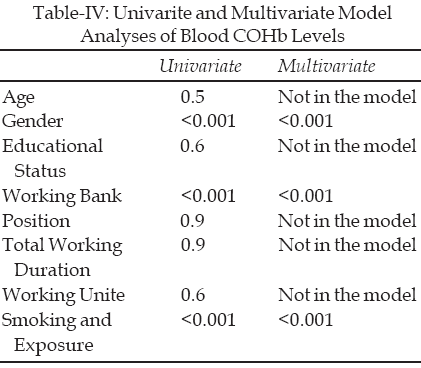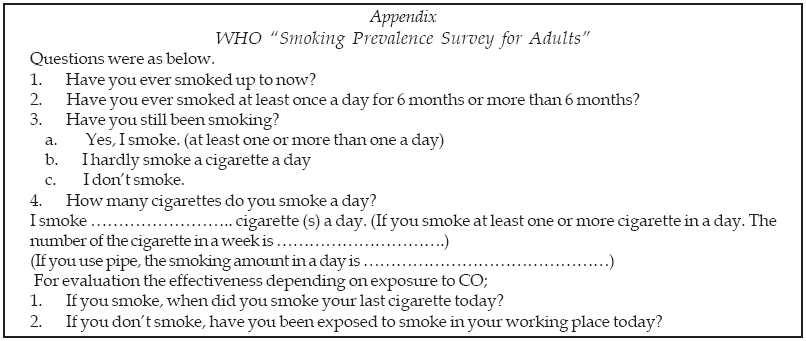|
|
||||
|
Published by : PROFESSIONAL MEDICAL PUBLICATIONS |
||||
|
ISSN 1681-715X |
||||
|
||||
|
- |
||||
|
ORIGINAL ARTICLE |
||||
|
- |
||||
|
Volume 25 |
April - June 2009 (Part-I) |
Number 2 |
||
|
|
||||
|
|
||||
|
|
||||
|
Published by : PROFESSIONAL MEDICAL PUBLICATIONS |
||||
|
ISSN 1681-715X |
||||
|
||||
|
- |
||||
|
ORIGINAL ARTICLE |
||||
|
- |
||||
|
Volume 25 |
April - June 2009 (Part-I) |
Number 2 |
||
|
|
||||
|
|
||||
Effects of passive smoking in the work place on expiration
air Carbon Monoxide (CO) and Carboxihemoglobin
(COHb) levels: Results of a survey in Turkey
Nurhan Meydan Acimis1, Mehmet Bostanci2,
Ahmet Ergin3,
Ali Ihsan Bozkurt4, Aysun Ozsahin5
ABSTRACT
Objective: To assess the prevalence of smoking and the effects of passive smoking among bank employees.
Methodology: This cross-sectional study was conducted between 2001 and 2002. Data was collected through questionnaire. The level of Carbon Monoxide (CO) and the percentage of Carboxihemoglobin (COHb) level in the blood were measured by using Bendfond Pico Smokerlyser. Chi-square and ANOVA were used.
Results: Six hundred fifty four respondents participated in the study which included 384 (58.7%) male and 267 (40.6%) female. The mean value for CO in the expiration air was 14.57±11.1 ppm [(18.49±11.21, 7.74± 5.71 and 4.85± 2.35; for current smokers, non-smokers with current exposure and non-smokers without current exposure, respectively (p<0.001)]. The mean value for COHb % was 2.97±1.9 [(3.60±1.88, 1.80± 1.17 and 1.21± 0.99; for current smokers, non-smokers with current exposure and non-smokers without current exposure, respectively (p<0.001)].
Conclusion: Passive smoking is still a significant health problem in the work place. Anti-tobacco implementations should be carried out strictly in all work places.
KEY WORDS:
Carbon Monoxide, Carboxihemoglobin, Passive smoking, Banks, Laws.Pak J Med Sci April - June 2009 Vol. 25 No. 2 190-195
How to cite this article:
Acimis NM, Bostanci M, Ergin A, Bozkurt AY, Ozsahin A. Effects of passive smoking in the work place on expiration air Carbon Monoxide (CO) and Carboxihemoglobin (COHb) levels:Results of a survey in Turkey. Pak J Med Sci 2009;25(2):190-195.
1. Selim KILIC MD.
Associate Professor, Dept. of Public Health
2. Recai OGUR, MD,
Associate Professor, Dept. of Public Health
3. Hakan Yaren, MD,
Assistant Professor, Dept. of CBRN Defence
4. N.Gokce Akkoyun, MD,
5. Erhan Kupcuk, MD,
1-5: Gulhane Military Medical School,
Turkey.
Correspondence
Selim KILIC, MD
E-Mail: drselimkilic@yahoo.com
* Received for Publication: January 06, 2009
* Revision Received: February 18th 2009
* Revision Accepted: February 25th 2009
INTRODUCTION
There has been a significant increase in the use of complementary and alternative medicine (CAM) in recent years worldwide.
1-4 There is also significant and growing interest in the introduction and integration of CAM instruction into medical curriculums not only in USA all over the world, parallel to the increase of CAM use.5-8 There were many studies which were conducted in different countries to determine the knowledge and attitudes of medical, pharmacy and nursing school students, staff and faculties on CAM.8-17 Although in most of the studies, the knowledge, positive interest and attitude of students were reported very high, the results were varied according to gender, classes or school that students attended.5,10-16The aim of this study was to determine the knowledge level of Gulhane Military Medical School students on complementary and alternative medicine (CAM) and also to asses whether knowledge level and positive attitude differ with respect to medical class and gender or not.
METHODOLOGY
This descriptive study was conducted on April 2008. We sought to enroll all students’. Four hundred one students participated in the study (participation rate= 62.6%). The questionnaire we used contained demographic questions without name identification, and multiple-choice questions related to 14 frequently used CAM therapies.
We asked five questions to asses students‘attitudes toward CAM similar to ones Chez et all used in their published study on American medical students’.
18 The questionnaire was offered to the students in the first three medical classes during their course session in lecture theatres and to the students in the last three classes’ in their working rooms. Two investigators were ready to respond the questions of first three classes. Because of their busy clinical activities, the participation of later three classes were low.We did not discuss anything related to CAM with the students before or after they completed the survey. The data were analyzed by using SPSS (version 11.0, Chi., Il., USA). Descriptive statistics were presented as frequency and proportions. Chi square test was used to evaluate the significance of difference. A p value of <0.05 was accepted as statistically significant.
RESULTS
Of the total 401 students, 374 were male (93.3%) and 27 were female (6.7%). The biggest group was third year medical students while the sixth class students were the smallest one (Table–I).

Knowledge of meditation, Tai Chi, ayuverdic medicine, massage, reiki, spirituality (pray) and herbal therapy were found statistically different between male and female students. Female students know more about Tai Chi, ayuverdic medicine, reiki, whilst the males had more knowledge about meditation, massage, spirituality (pray) and herbal therapy (p<0.05). Acupuncture was the most known modality among female students while hypnosis was the first among males (Table-II).

There were also statistically significant differences about the knowledge of three CAM modalities between medical classes. Third year class students knew more about osteopathy and spirituality while the fifth year class students were the best for feedback (p<0.05). Hypnosis was the most known modality in all medical classes. Meditation, acupuncture, herbal medicine, spirituality, massage were all known at least to half of the students in all classes (Table-III).

We found that awareness about use of CAM information sources was higher in female students than male students. Students obtained information on CAM mainly through internet (92.6% vs. 87.2% for female and male students, respectively), books (66.7% vs. 54.8%). newspapers/journals (40.7% vs. 29.9), and TV/radio (40.7% vs. 27.2%). The differences were not statistically significant (p>0.05).
The proportion of students who believe the benefits of CAM modalities in medicine was found 64.9%. Although female students had more positive attitude toward CAM than male students, there was no statistically significant difference (77.8% vs. 64.5%, p=0.160).
We evaluated the attitude towards CAM by using 5 questions and we found some statistically significant differences between different medical classes. In general the first three year medical class students had more positive attitudes towards CAM. While fifth year medical class students had the most negative attitude (Table-IV).

DISCUSSION
Nowadays complementary and alternative medicine modalities are more commonly included in medical schools’ curriculum. Although there is no specific course related with CAM modalities in our medical school curriculum, some faculties talk about some CAM modalities during their courses. Medical training period in Turkey is six years. Since our medical school is a military institution, the number of female students who are accepted is limited. But the ratio of female and male students is close to each other in other medical schools in Turkey. Although the number of the students in each medical class is approximately the same, the response rates differed in the study. While the response rate was 91% for first year medical class, it was approximately 40% for sixth year class. The response rate among male students was 61.5% as compared to 80% for female students.

The most known CAM therapeutic modalities among students were hypnosis, acupuncture and mediation. Yeo and et all reported acupuncture as the first known modality better amongst medical students in Singapore.
16 It is found that knowledge of CAM modalities among medical students differ in different countries. Massage, herbal medicine and meditation were the most knowledgeable among American students,18 acupuncture, meditation and massage were the highest self-perceived knowledge amongst the Australian students,19 whilst the acupuncture and homeopathy were the best-known methods, primarily from courses or seminars among German medical students.20 The knowledge of CAM among medical students in USA9-14 was more than our group that might be the result of CAM integration in the medical curriculum in USA but our students had more knowledge of CAM than British and Singaporean medical students.15-16In our study we also found that the knowledge of CAM modalities differs with respect to gender and medical class. The differences for the sources of information between genders might be the explanation of why female students knew more about Tai Chi, ayuverdic medicine, and reiki. In Turkey most of the people are not aware of Tai Chi, ayuverdic medicine, reiki but people who use internet and people who watch TV programs related with health have higher probability to be aware of these modalities. We do not have any idea why male students are more knowledgeable about CAM therapeutic modalities. We also found differences for knowledge of three CAM modalities among different classes of students. In general the last three classes were more aware of biofeedback. The difference for osteopathy was found because of third year class medical students’ higher knowledge and this might be due to pathology course they took in their curriculum. It was surprising to find out higher knowledge of spirituality in the first three class students. May be the last three class students were aware of spirituality but since they had more experience with positive science, it might be the reason for them not to accept spirituality (praying) related with medicine.
In our study group internet, books and newspaper/journals were the main information sources for CAM. The sources among Czech pharmacy students were found as internet, journals and books. Only 10% of Czech students relied on other sources of information such as television, radio, lectures on CAM, whilst at least 20% of our study group stated TV/ radio.
21In our study we found the proportion of students who indicated positive attitude toward complementary and alternative medicine as 64.9%. There are many studies which report higher proportions. The positive general attitude is reported more than 80% among medical students in USA,
9-14 and more than 85% amongst medical students in Singapore.16 But Furnham et all and, Brinkhaus et all have reported lower positive attitudes proportions than ours among British and German medical students.7,15 In some studies female medical students were found to have more positive attitude towards CAM than male students.14,22 We could not find statistically significant difference in our results as compared to other studies.The attitudes toward CAM differ in different classes. In general the first three class students had more positive attitudes towards CAM whilst the fifth medical class students had the most negative attitude. Our result was consistent with the studies which were conducted among British medical students and Czech pharmacy students.
15,21Our study has some limitations. It was conducted in a military medical institution where female student numbers were limited and may not be generalizable to other institutions and settings in our country. The lower participation rates for the last three medical classes may affect the final results.
Comparative studies in other medical schools in Turkey may help to provide more definite assessments not only to determine the level of knowledge and the attitudes of medical students on CAM but also what students think about the integration of CAM courses in medical curriculum.
Acknowledgements
This study was not supported through any grant. The authors would also like to thank Mahir Gulec, Muharrem Ucar, Adnan Atac for their writing assistance and Troy McCarthy for his most helpful review of the manuscript.
REFERENCES
1. Health effects of exposure to environmental tobacco smoke. The report of the California Environmental Protection Agency. Smoking and Tobacco Control Monograph 10, National Cancer Institute; 1999.
2. International Consultation on Environmental Tobacco Smoke (ETS) and Child Health. WHO Tobacco Free Initiative, WHO/NCD/TFI/99.10;1999.
3. Reducing the Health Consequences of Smoking: 25 years of progress. A report of the Surgeon General. US Dept. of Health and Human Services; 1989.
4. Effects of passive smoking on Health, National Health and Medical Research Council. Australian Government Publishing Service; 1987.
5. Respiratory health effects of passive smoking: Lung cancer and other disorders. The report of the US Environmental Protection Agency; 1993.
6. Wallace BR. Public Health and Preventive Medicine. 14th. edition, New York 1998;825.
7. Ford MD, Delaney KA, Ling LJ, Erickson T. Clinical Toxicology. Philadelphia 1. Edition; 2001;713-4.
8. State- Specific Prevalence of Current Cigarette Smoking Among Adults Who Work in a Smoke Free Environment-Unite States 1999. JAMA 2000;(284):2865-66.
9. Braunwald E, Fauci AS, Kasper LD, Hauser SL, Longo DL, Jameson JL. Principles Internal Medicine. 15th ed. 2001;2609.
10. Sezer ER, Acik Y, Oguzoncul F, Dinc E, Gungor Y. Elazig II Merkezinde Bulunan Bankalarda Calisan Kisilerin Sigara Icme Sikliklari ve Karbonmonoksit Duzeyleri. Saglik Icin Sigara Alarmi 1998-2001;4(1-4):88-93.
11. Fezan A, Ozdamar K, Oner SD. Turkey de Sigara Icme Aliskanligi Tahmini. Sigara ve Saglik Ulusal Kongresi; 1999;28.
12. Brenner H, Born J, Novak P, Wanek V. Smoking Behavior and Attitude Towars Smoking Regulations and Passive Smoking in the Work Place. A Study among 974 Employees in the German Metal Industry. Prev Med 1997;26(1):138-43.
13. Twose J, Schiaffino A, Garcia M, Marti M, Fernandez E. Prevalence of exposure to environmental tobacco smoke in an urban population. Med Clin (Barc) 2004;16:123(13):496-8.
14. Knutsson A, Nilson T. Tobacco Use and Exposure to Environmental Tobacco Smoke in Relation to Certain Work Characteristics. Scand J Soc Med 1998;26(3):183-9.
15. Reynols P, Goldberg DE, Hurley S. California Teachers Study Steering Committee. Prevalence and Patterns of Environmental Tobacco Smoke Exposures among California Teachers. Am J Health Promot 2004;18(5):358-65.
16. Simoni M, Carrozzi L, Baldacci S, Pedreschi M, Di Pe De F, Angino A, et al. Characteristics of Women Exposured and Uexposured to Environmental Tobacco Smoke in a General Population Sample of Nort Italy. Eur J Epidemiol 20001;17(4):363-8.
17. Moussa K, Lindstron M, Ostergren PO. Socioeconomic and Demographic Differences in Exposure to Environmental Tobacco Smoke at Work: The Scania Public Health Survey 2000. Scand J Public Health 2004;32:194-202.
18. Invernizzi G, Betoncelli G, Dambrosio G, Zappa M, Calzolari M, Mazza R, et al. A.MI.CO Project network- based Program to Improve Smoking Cessation in G.P’s Ofiice. J Respiratuar Society 2001;12:178.
19. Roscovanu. COHb Levels of Selected Population Segments Living In Urban And Rural Enviroments of North Rhine–Westphalia 1985;180:359-80.
20. Laranjeria R, Pillon S, Dunn J. Environmental Tobacco Smoke Exposure Among Non Smoking Measurement of Expired CO Levels. Sao Paulo Med J 2000;6.118(4):89-92.
21. Kamei M, Yanagiawa Y. Estimation of CO Exposure of Road Construction Workers in Tunnel. Ind Health 1997;35(1):119-25.
22. Tuttd D, Harris W. Where there’s Smoke. Carbon monoxide Exposure in Smoking Smoke Free Workplaces. Community Health Study 1990;14(3):297-302.
23. Kocasoy G, Yalin H. Determination of Carboxyhemoglobin Levels and Health Effects on Officers Working at the Istanbul Bosphorus Bridge. Environ Sci Health A Tox Hazard Substances Environ Eng 2004;39(4):1129-39.
HOME | SEARCH | CURRENT ISSUE | PAST ISSUES
Professional
Medical Publications
Room No. 522, 5th Floor, Panorama Centre
Building No. 2, P.O. Box 8766, Saddar, Karachi - Pakistan.
Phones : 5688791, 5689285 Fax : 5689860
pjms@pjms.com.pk